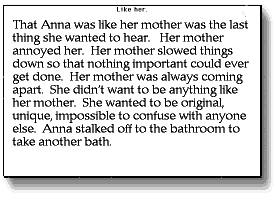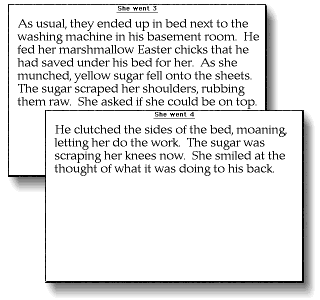those kids
The hypertext landscape is strangely devoid of young people. If you listen to the Industry, you'd think that hypertext was primarily about kids. The trade magazines are filled with games aimed for the parent's dollar, while pundits lament that hypertext may keep today's children from reading exactly the way they read. Your local superstore, of course, has shelves crammed with edutainment stories of imaginarily perfect kiddies and critters: safe, uncontroversial, utterly unreal.
In Small and Large Pieces was written in Storyspace. Each of the pagesshown here contains numerous links which create a subtle and complex textual structure.
Like many Storyspace hypertexts, Cramer's work depends on conditional links that cannot be replicated on the Web.
That's one reason that Kathryn Cramer's In Small & Large Pieces is unforgettable: its central character is brutally real. Young Anna isn't a nice girl. She isn't cute. She isn't anyone's role model. But she's so vividly imagined that we all know her.
Harry Goldstein, in his review of In Small & Large Pieces for The Utne Reader, nails the central point:
"Growing up isn't for the faint of heart. . . . "In Small & Large Pieces" is a psychic journey into the backwaters of adolescence, where Anna takes us through the looking glass (in, of course, more ways than one) and shows us a reflection of ourselves."

Nostalgia for an imaginary past. . . .
 Anna's impact is all the greater because the multimedia industry has led us to expect that children, when portrayed on the computer screen, will be sanitized, artificial, and unreal. If the industry holds a mirror up to nature, it is a mirror that is flattering but empty, full of enterprising and care-free kids who hunt harmlessly imaginary villains and decode arcane puzzles. This is, perhaps, a side-effect of the industry's indulgence in nostalgia for an imaginary past, a self-deception more often seen when musing about the bygone age when kids spent all their free time reading, indeed, when everyone enjoyed fine leather editions of timeless literature.
Anna's impact is all the greater because the multimedia industry has led us to expect that children, when portrayed on the computer screen, will be sanitized, artificial, and unreal. If the industry holds a mirror up to nature, it is a mirror that is flattering but empty, full of enterprising and care-free kids who hunt harmlessly imaginary villains and decode arcane puzzles. This is, perhaps, a side-effect of the industry's indulgence in nostalgia for an imaginary past, a self-deception more often seen when musing about the bygone age when kids spent all their free time reading, indeed, when everyone enjoyed fine leather editions of timeless literature.
If, as Jay David Bolter argues in his classic Writing Space, this is "the late age of print", it is the writer's responsibility to see clearly, to look at people (including kids) and art (including new media) as they are, not as focus groups or corporate boards imagine they must once have been in some lost time when we were all (and ever would be) young, untroubled, and safe.
